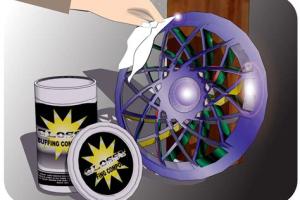Mastering the Art of Painting Over Chrome: A Step-by-Step Guide

-
Quick Links:
- Introduction
- Why Paint Chrome?
- Choosing the Right Paint for Chrome
- Preparing the Chrome Surface
- Painting Techniques
- Drying and Finishing
- Case Studies
- Expert Insights
- Common Mistakes to Avoid
- FAQs
Introduction
Painting over chrome surfaces can seem daunting due to the shiny finish and inherent slickness of chrome. However, with the right preparation and materials, you can effectively transform chrome into a beautifully painted surface. This guide will walk you through the entire process, from understanding why you might want to paint chrome to the actual techniques, ensuring you achieve a professional finish.
Why Paint Chrome?
There are several reasons you might want to paint over chrome:
- Customization: Personalize your vehicle or object to match your style.
- Restoration: Restore old chrome parts that have lost their shine.
- Protection: Protect chrome from rust and corrosion.
- Cost-effectiveness: Painting can be cheaper than replacing chrome surfaces.
Choosing the Right Paint for Chrome
When selecting paint for chrome surfaces, consider the following options:
- Spray Paint: Quick and easy application, ideal for small areas.
- Acrylic Paint: Provides a durable finish, suitable for larger surfaces.
- Epoxy Paint: Excellent for high durability, often used in automotive applications.
Ensure that the paint is specifically designed for metal surfaces to achieve the best results.
Preparing the Chrome Surface
Preparation is crucial for a successful paint job. Follow these steps:
- Clean the Surface: Use soap and water or a degreaser to remove dirt and grime.
- Sand the Surface: Lightly sand the chrome with fine-grit sandpaper to create a rough texture for better paint adhesion.
- Wipe Down: After sanding, wipe the surface with a clean cloth to remove dust.
- Apply Primer: Use a self-etching primer specifically designed for metal to ensure the paint adheres properly.
Painting Techniques
Once your surface is prepared, you can begin painting. Consider these techniques:
- Spray Painting: Hold the can 6-12 inches away from the surface and use a sweeping motion.
- Brushing: Use a high-quality brush to apply paint for detailed areas.
- Rolling: For larger surfaces, a foam roller can provide a smooth finish.
Apply multiple thin coats rather than one thick coat to avoid drips and ensure an even finish.
Drying and Finishing
After painting, allow the surface to dry completely. Follow the paint manufacturer's instructions for drying times. Once dry, apply a clear coat for added protection and shine.
- Clear Coat: Enhances durability and provides a glossy finish.
- Buffing: Once fully cured, buff the surface to achieve an even higher shine.
Case Studies
Here are a few real-world examples of successful chrome painting projects:
- Classic Car Restoration: A 1965 Mustang was transformed with a new paint job over its chrome bumpers, using a specialized automotive paint that ensured longevity.
- Home Decor: A chrome lamp was successfully painted with a metallic finish paint, enhancing its aesthetic and blending it with modern decor.
Expert Insights
Industry professionals suggest the following tips:
- Always test paint on a small area first.
- Ensure proper ventilation when painting, especially indoors.
- Use painter's tape to protect areas you don't want to paint.
Common Mistakes to Avoid
To ensure a successful paint job, avoid these pitfalls:
- Skipping surface preparation.
- Using the wrong type of paint.
- Applying paint in high humidity or cold temperatures.
- Rushing the drying process.
FAQs
1. Can I paint chrome without sanding?
It's not recommended, as sanding helps the paint adhere better.
2. What type of primer should I use on chrome?
A self-etching primer specifically for metal surfaces works best.
3. How long does it take for paint to dry on chrome?
Drying time varies by paint type, but typically ranges from 1-24 hours.
4. Can I use regular spray paint on chrome?
No, use paint designed for metal surfaces for optimal results.
5. Is it better to spray or brush paint chrome?
Spray painting is generally easier and provides a smoother finish.
6. How can I remove paint from chrome?
Use a paint stripper or sandpaper to carefully remove paint.
7. Will the paint chip off chrome easily?
If properly prepared and primed, the paint should adhere well and be durable.
8. Can I paint chrome parts on my car?
Yes, but make sure to use automotive-grade paint for the best results.
9. How do I maintain painted chrome surfaces?
Regular cleaning with mild soap and water will help maintain the finish.
10. What is the best clear coat for chrome?
Acrylic clear coat is often recommended for durability and shine.
Random Reads
- Unlock iphone without computer
- How to help around the house
- How to have infinite money in gta v
- How to set up voicemail on tracfone
- How to join advanced server mlbb
- How to jailbreak your phone
- How to repair christmas lights
- How to repair a blown speaker
- Two simple ways to reboot an ipad
- Two easy ways to draw on pictures on android